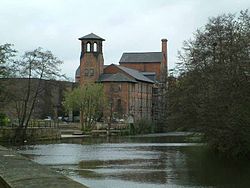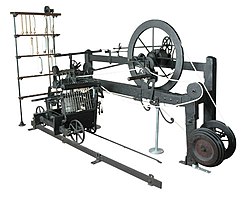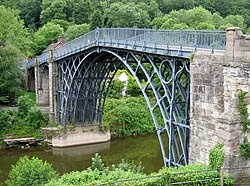Industrial Revolution

The Industrial Revolution is the name of the time when there was a big change in the way things were made. Instead of things being hand-made in small workshops, they were made more cheaply in large quantities by machines in factories. This improved the idea of assembly lines. People found that they could make many more things using an assembly line than each person working individually.
This mass production meant that the goods were sold for less. It started in the 1760s.[1] Many people began to move from an agricultural based life in the country to the towns where the factories offered more and better paid work.
A Second Industrial Revolution began in the 1870s.
Beginnings
The Industrial Revolution began in Great Britain in the 18th century. Many of the technological innovations were of British origin.[2] In particular, the County of Shropshire was important, for it had both minerals (e.g. iron ore and coal) and transport on the River Severn.[3][4][5] This led to the group of industries near the Ironbridge Gorge and the town of Coalbrookdale.
In the mid-18th century Britain was the world's leading trading nation.[6] It controlled a global trading empire with colonies in North America and Africa, and with some political influence on the Indian subcontinent, through the activities of the East India Company.[7] The development of trade and the rise of business were major causes of the Industrial Revolution.
The Industrial Revolution marks a major turning point in history. Almost every aspect of daily life was influenced in some way. Average income increased, and population grew rapidly. Some economists say that the major impact of the Industrial Revolution was that the standard of living for the general population began to increase consistently for the first time in history, but others have said that it did not begin to meaningfully improve until the late 19th and 20th centuries.
The revolution spread to Europe and the Americas, especially the United States, by the early 19th century. Samuel Slater, who had been an apprentice in an English cotton factory, disguised himself and came to America. He reconstructed a spinning machine from memory and built a factory of his own.
New ideas and inventions were also taken up and used in mining, the working of metals, and in the transport of goods. Around the same time new ideas in farming were leaving some farm workers without jobs. They added to the move to the industrial towns where they sought out work in factories.
The most important new invention of the industrial revolution was the steam engine. The steam engine, improved by James Watt around 1776, was used to power the factories and pump out the deeper mines. It was also used in railway engines. The heat from burning coal became the main source of power.
Problems
Living standards rose and people generally became richer and healthier and had more children who survived to be adults instead of starving. The resulting population growth in England caused new problems. Where only a few people had been rich because they owned land, now more became very rich thanks to industry. More, however, were still poor and lived in poor conditions. Children and women had to work for a long time for little pay. Often several families crowded into very small apartments. Working at different times, family members would take turns sleeping when they were not working.[8] Families were usually unable to get together. 12, 14, or even 18-hour workdays were common.
Advancements
During the industrial revolution, new technology brought many changes. For example:
- Canals were built to allow heavy goods to be moved easily where they were needed.
- The steam engine became the main source of power. It replaced horses and human labor.
- Cheap iron and steel became mass-produced. Steel replaced wood as material for building many of the new things.
- Machine tools became commonplace. Things could now be mass-produced in factories instead of making them by hand.
- Seed drills and other agricultural machinery brought a British agricultural revolution. Fewer people were needed to work in farming, so many moved to towns and found new jobs in the factories. Many of the new jobs could be harsh, and sometimes dangerous.
- Railways were built all around England and then the world. They carried freight and passengers much more quickly and cheaply than before.
- Steamships began to replace sailing ships. They could be larger and faster than sailing ships and did not depend on wind and weather.
- The spinning Jenny and power loom made it easy to mass-produce clothes and fabrics.
Industrial Revolution Media
John Lombe's silk mill site today in Derby, rebuilt as Derby Silk Mill
A model of the spinning jenny in a museum in Wuppertal. Invented by James Hargreaves in 1764, the spinning jenny was one of the innovations that started the revolution.
The only surviving example of a spinning mule built by the inventor Samuel Crompton, the mule produced high-quality thread with minimal labour, now on display at Bolton Museum in Greater Manchester
The interior of Marshall's Temple Works in Leeds, West Yorkshire
The reverberatory furnace could produce cast iron using mined coal; the burning coal is separated from the iron to prevent constituents of the coal, such as sulfur and silica, from becoming impurities in the iron. Iron production increased due to the ability to use mined coal directly.
The Iron Bridge in Shropshire, England, the world's first bridge constructed of iron, opened in 1781.
Horizontal (lower) and vertical (upper) cross-sections of a single puddling furnace
References
- ↑ "Industrial History of European Countries". www.erih.net.
- ↑ Horn, Jeff; Rosenband, Leonard; Smith, Merritt (2010). Reconceptualizing the Industrial Revolution. Cambridge MA, USA, London: MIT Press. ISBN 978-0262515627.
- ↑ Szostak, Rick 1991. The role of transportation in the industrial revolution: a comparison of England and France. Montreal: McGill-Queen's University Press.
- ↑ Usher, Abbott Payson 1920. An introduction to the industrial history of England. University of Michigan Press.
- ↑ Uglow, Jenny 2002. The Lunar Men: the friends who made the future 1730–1810. London: Faber and Faber.
- ↑ Reisman, George (1998). Capitalism: A complete understanding of the nature and value of human economic life. Jameson Books. p. 127. ISBN 0-915463-73-3.
- ↑ Landes, David (1999). The Wealth and Poverty of Nations. W.W. Norton & Company. ISBN 978-0393318883.
- ↑ Koontz, Terri, Mark Sidwell, S.M.Bunker (June 2005). World Studies. Greenville, South Carolina: Bob Jones University Press. ISBN 1-59166-431-4.
Related pages
Other websites
| Wikimedia Commons has media related to Lua error in Module:Commons_link at line 62: attempt to index field 'wikibase' (a nil value).. |
- Industrial Revolution Citizendium










